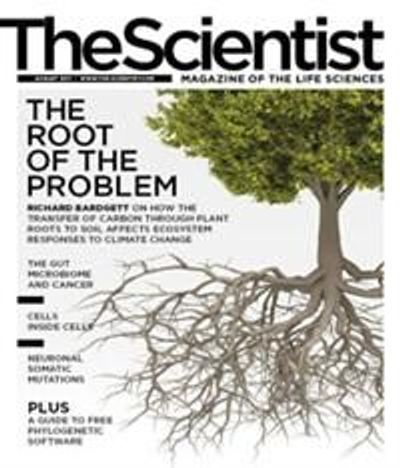 ANDRZEJ KRAUZ
ANDRZEJ KRAUZ
Someone who “can’t see the forest for the trees” is so bogged down in minutiae that the larger context gets missed. It’s a problem for a lot of researchers, and yet getting lost in the trees can occasionally lead to serendipitous new discovery. This issue of The Scientist boasts a number of articles by and about people who are doing just that: using trees both figuratively and literally to fit data into a bigger picture.
First on the tree list: Ernst Haeckel’s famous Pedigree of Man diagram, originally published in 1874—a gnarly old tree with a thick trunk that rises straight up to H. sapiens at its apex—is featured in the Foundations column. Haeckel’s construction of the tree reflected his view that the developmental stages through which an embryo passed recapitulated forms lower down the tree. Although we owe the term “phylogeny” to Haeckel, his tree...
And in our cover story, "The Root of the Problem," ecologist Richard Bardgett literally takes on trees—forests full of them. He paints the big picture of the pivotal role played by microorganisms and animal communities that live belowground, where they respond to increased concentrations of atmospheric carbon dioxide in ways that have complex consequences for the cycling of greenhouse gases. Trees, forests, and grasslands are touted as possible mitigators of climate change, sopping up excess CO2. But it is becoming increasingly clear that attention must also be paid to microbial communities in the soil. As we go to press, a meta-analysis appearing in Nature reports that when plants take up more CO2, soil anaerobes associated with their roots release nitrous oxide and methane into the atmosphere, countering the cooling effect of plants by 17 percent (475:214-16, 2011). Clearly, further research is needed to inform smart land-management practices.
People are using trees both figuratively and literally to fit data into a bigger picture.
Developmental neurobiologist Tom Curran wants to zero in on the “trees” that make up another kind of forest—the >100 billion neurons in our brains. In his Thought Experiment, Curran envisions a method for picking out brain cells with somatic mutations acquired during development, then sequencing the DNA to understand the genetics underlying neurological and psychological diseases.
Is cancer a hundred different diseases? Will we ever be able to see the forest for the trees? At the end of 2010, NCI Chief Harold Varmus initiated a series of workshops and a website devoted to what he calls “provocative questions.” On the site he remarks that after 40 years doing research, it’s time to think about more than “the questions we’ve been working on for many years, the questions that are in the headlines every day about the nature of cancer. We’re uncovering new observations that need to be pursued, we’re looking back at questions that were never satisfactorily answered in the past...questions that have been mysterious, perplexing, forgotten.” The list is long and interesting, as revealed by a visit to the website.
One of these “provocative questions” arose during a February 2011 Big Think panel discussion about how close we are to a cancer cure: Why are so few tumors found in the 25-foot-long small intestine compared to the 150,000 US cases of cancer arising in the 6 or so feet of the colon? Panelist Varmus remarked that this question points to a “very interesting new theme in cancer research: what is the role of the microorganisms we carry around with us—the microbiome?” And exactly that theme is amply discussed by Michelle Rooks and Wendy Garrett in "Sharing the Bounty," where they explain that bacteria living in our guts are usually good for us, but can sometimes contribute to cancer risk.
The Scientist’s own Jef Akst reports on a provocative question that fits Varmus’s “mysterious, perplexing, forgotten” category: the long-observed but little understood process in which cancer cells are seen to ingest or be invaded by other cells, including lymphocytes, neutrophils, natural killer cells, and even other tumor cells—and what that might mean for cancer treatment.
Seeing the forest for the trees—seeing the trees for the forest. Asking the right questions.
Mary Beth Aberlin
Editor-in-Chief
eic@the-scientist.com
Interested in reading more?




